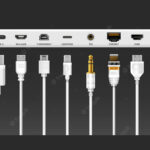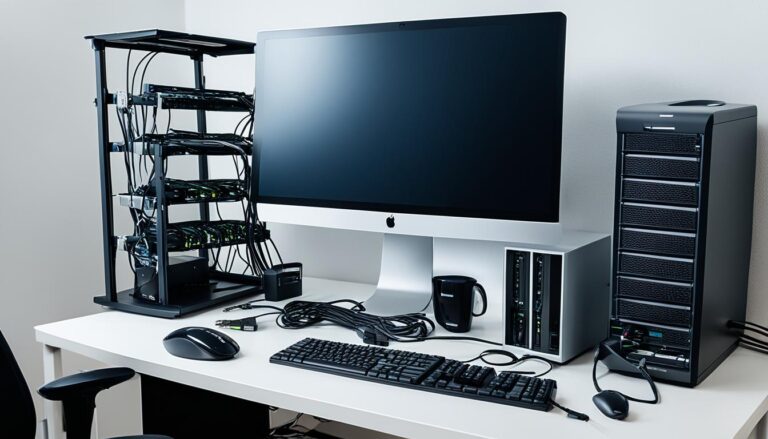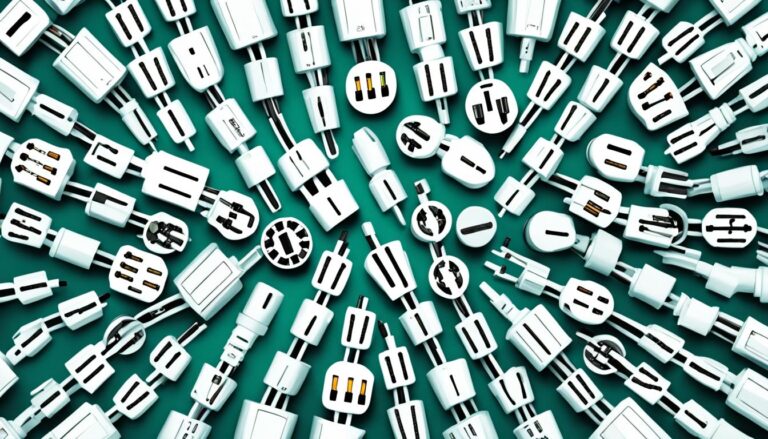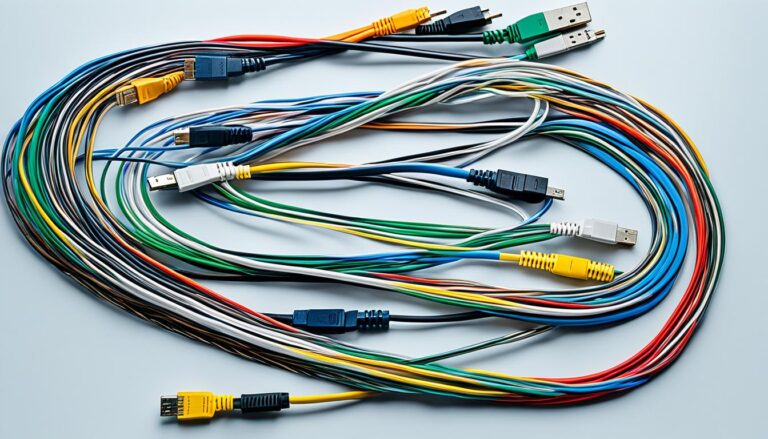Welcome to our guide on the IRDA port. This feature lets computers communicate without wires, thanks to infrared technology. In this article, we’ll dive into how the IRDA port helps devices share data easily. Whether you’re into tech or just want to know how your computer works, you’ll find useful info here.
The IRDA port stands for Infrared Data Association. It’s a tech standard for sending data with infrared light. This cool technology allows laptops, printers, and PDAs to talk to each other without cables. Imagine sending files, syncing schedules, and printing documents wirelessly.
With the IRDA port, wireless communication becomes easy. It sends data at speeds up to 4Mbps and can work up to 10 feet apart. However, devices must see each other to communicate.
We will now look at the basics of IRDA technology, starting with what it is and its role in wireless communication. Then, we’ll discuss how data moves between devices using IRDA. Lastly, we’ll look at IRDA’s uses and weigh its pros and cons. Let’s uncover the possibilities of the IRDA port.
What is IrDA?
IrDA stands for Infrared Data Association. It’s a group started in 1994. It’s made up of different special groups. They provide rules for wireless infrared communication. Their main goal is to make wireless data sharing possible over short distances. This is usually no more than one meter away, using direct aim.
This tech is found in portable devices like mobile phones and laptops. Also in cameras, printers, and medical gear. It’s good for secure data sharing, seeing direct line communication, and has a low error rate. This makes it very effective.
IrDA allows gadgets to connect directly and share data without cables or the internet. It uses the infrared spectrum. Here, specific light wavelengths carry information between gadgets that work together. The infrared systems keep the communication secure and free from outside interruptions.
“IrDA tech changed wireless communication. It made data sharing over short spans efficient and secure. Its direct aim feature let users transfer info between devices easily. No wires or tricky setups needed.” – [Insert Expert]
IrDA helps users ship files, contacts, and messages between their devices easily. It shines in situations where devices must see each other. Like in using remote controls, printing, or sharing medical information between gadgets.
Key Features of IrDA:
- Physically secure data transfer: IrDA needs devices to see each other to connect. This stops unwanted guests from grabbing the data.
- Efficient and reliable: IrDA has a minimal error rate. This means data goes through clearly. The rules it follows check and fix errors. This cuts the chance of data mess-ups during swaps.
- Wide range of applications: IrDA is used in many areas. It’s key in fields like healthcare. Here, medical gadgets need to link up to computers or databases safely.
IrDA has been key in making wireless data sharing over short spaces work. Even though new techs like Bluetooth and Wi-Fi have taken over, it’s still used. It’s perfect for cases where secure and straightforward line-of-sight communication is needed.
IrDA Protocol Layers
The IrDA protocol is made up of different layers that help devices talk to each other smoothly. These layers make sure data moves well and allows for information to be shared.
Application Layer
The application layer offers key functions for activities like syncing, sending objects, and moving binary files. It lets devices align data, share objects, and send files easily.
Session Layer
This layer includes protocols for managing sessions and moving data. Protocols like IrOBEX and IrLAN are part of it. They handle sessions well and make sure data moves between devices without problems.
IrLMP (Infrared Link Management Protocol)
The IrLMP is another crucial layer in the IrDA. It’s about making connections and handling channels between devices. With the necessary setup for channel management, IrLMP allows for dependable communication.
Physical Layer
This layer deals with sending infrared signals between devices. It’s all about the physical side of sharing data, like how signals are made and sent. By ensuring a stable connection, it helps with successful information transfer.
Getting to know the IrDA protocol layers helps in understanding how infrared communication works. Each layer has a vital role in making wireless data sharing and communication between devices possible.
IrDA Applications
IrDA technology has many applications. It’s often used for sending data between computers and mobile devices wirelessly. This tech lets people share files, sync schedules, and print documents with no cables needed.
It’s also great for device-to-device communication. This is perfect when a clear path between gadgets is necessary. For example, in healthcare, it helps with sending patient data to computers quickly. This boosts efficiency, reduces mistakes, and improves patient care.
IrDA technology has been key in improving communication in many areas. In the automotive sector, it speeds up data transfer between diagnostic tools and cars. This makes vehicle checks and repairs faster and easier.
IrDA is not just for work; it’s in our homes too. It connects games consoles wirelessly, making multiplayer games more fun without messy cables. It also turns our mobiles into remote controls for our TVs and sound systems.
To sum up, IrDA technology is super versatile. It’s used in many fields, including electronics and healthcare. Its wireless data transfer and direct device links make our lives easier and more efficient.
Advantages and Disadvantages
IrDA technology stands out for its secure data transfer method. It is safer than some wireless technologies that can be hacked or interfered with. This high security is great for when keeping data safe is crucial.
IrDA also shines in its efficiency and low bit error rate. It sends data fast and without errors. This is key in places like hospitals or industries, where correct data transmission matters a lot.
Another big plus is how little power IrDA devices use. They’re made to be energy-efficient, which is good for battery-powered gadgets. Users can communicate wirelessly without quickly using up their battery.
But, IrDA isn’t perfect. One downside is its short range, only up to 10 feet. Devices must be close to each other for it to work. Plus, there needs to be nothing blocking their path.
Also, technologies like Bluetooth and Wi-Fi have overtaken IrDA. They work over longer distances and don’t need devices to see each other to connect.
Still, in certain situations, IrDA’s unique benefits can be very useful. It’s used where other wireless tech might fail due to interference or when secure, near communication is a must.
IrDA Advantages:
- Secure data transfer
- Efficient and low bit error rate
- Minimal power consumption
IrDA Disadvantages:
- Limited communication range (10 feet)
- Requires clear line of sight
- Largely replaced by Bluetooth and Wi-Fi
Conclusion
The IRDA port lets computers swap data wirelessly. It was made by the Infrared Data Association. This tech helps devices send data without cables.
It’s secure and works well, despite needing devices to be in direct sight of each other.
But, other wireless tech like Bluetooth and Wi-Fi have become more popular. They work over longer distances and are more flexible. Yet, in some cases where other signals interfere, IrDA is still useful.
Knowing what the IRDA port does is useful. Even though we often use other wireless options, IRDA is still good for certain wireless needs.
FAQ
What is an IRDA port?
An IRDA port allows computers to swap data wirelessly. It uses infrared communication.
What is the purpose of the Infrared Data Association (IrDA)?
The Infrared Data Association (IrDA) sets wireless infrared communication standards. It establishes data transfer protocols.
What are the layers in the IrDA protocol?
The IrDA protocol is made up of layers. These include the application layer and session layer. Also, there’s IrLMP (Infrared Link Management Protocol) and the physical layer.
What are the applications of IrDA technology?
IrDA technology helps devices like laptops and mobile phones share data wirelessly. These devices include cameras, printers, and medical devices.
It’s used for direct device communication. It also has applications in healthcare for wireless communication.
What are the advantages of using IrDA technology?
IrDA ensures safe data sharing and low energy use. It needs a clear sightline between devices but has a low error rate.
Are there any disadvantages of using IrDA technology?
Yes, it has drawbacks. It only works up to 10 feet apart. Devices must see each other to connect. Additionally, Bluetooth and Wi-Fi technologies have largely replaced IrDA.


















